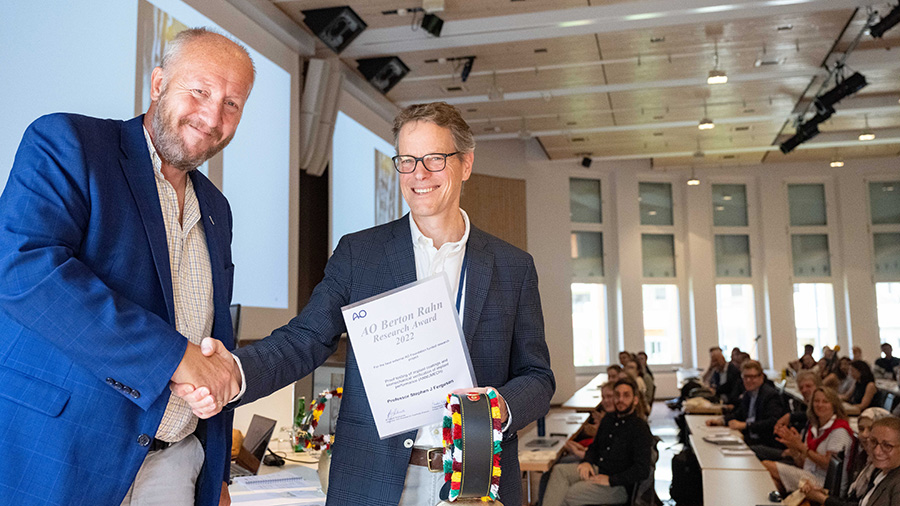The Berton Rahn Research Award—the three most recent winners

The late Berton Rahn during the European Cells and Materials (eCM) conference, Davos, Switzerland, July 2003
Every year, the best AO Foundation-funded research (excluding research at the AO Research Institute Davos) is honored with the Berton Rahn Research Award. The most recent award winners are Prof Dr Stephen Ferguson (2022), Prof Dr Jos Malda (2021), and Prof Dr Ling Qin (2020).
Initially known as the AO Research Fund Prize, the Berton Rahn Research Award was renamed in 2009 to recognize the numerous contributions made to the AO Foundation by Prof Dr med Dr med dent Berton Rahn. Prof Rahn, whose histological work on bone remodeling is world-renowned, joined the AO Research Institute Davos (ARI) in 1968 and became its vice-director in 1975. He passed away not long after retirement in March 2008.
In 2022, Prof Dr Stephen Ferguson won the Berton Rahn Research Award. Prof Ferguson, a professor of biomechanics at ETH Zurich, has collaborated for almost three decades with the AO Research Institute Davos (ARI), where he completed a research internship in 1994 and a PhD in hip joint and soft tissue biomechanics from 1996 to 2000.
In his work, Prof Ferguson focuses on the biomechanics of age-related diseases of the musculoskeletal system. With his research group, he develops new treatment methods based on novel biomaterials and fabrication methods for conditions related to increased bone fragility and disc degeneration.
One example is ANNUMECH, for which Prof Ferguson received this year's Berton Rahn Research Award. The project yielded a new method for fabricating fibrous membranes that can be used to repair lesions of the annulus fibrosus—the hard circular exterior that encases the soft inner core of intervertebral discs. The team successfully modified the already established biofabrication method of electrospinning, which employs electrostatic forces to create fine fibers.
"However, conventional electrospinning produces fibers in random orientation with tight spacing, which hampers cell and tissue growth," explains Prof Ferguson. "We were able to improve the process to achieve both specific fiber orientation and sufficient inter-fiber spacing."
The team also succeeded in furnishing the membranes' sides with differing characteristics—while one enhances cell and tissue adhesion, the other prevents it. The latter is particularly important in treatments deployed in close proximity to the sensitive neural structures of the spine.
Following the four-hour and 15-minute surgery and a second surgery a week later to correct a valgus- misalignment at tibia level, the patient was cared for at Kantonsspital Graubünden for 11 more days before being transferred to a rehabilitation center near Zurich.
“So far, his rehabilitation is going well. He starts walking with American crutches,” the surgeon reports, noting that he highly values innovations—like the Biphasic Plate DF—that improve patient outcomes. “Innovation is very important. Twenty years ago, I thought, ‘Oh, we can fix everything. We have our implants, so we don’t really need new solutions,” he says. “But now we have completely different implants than we had 20 years ago. Innovation, for me, is a new product or technique that adds value for our patients—and that value is what makes the difference. The AO's Development Incubator is a valuable resource for people around the world to find support for their really innovative ideas and bring them to market.”
‘The reason I do this work’
For ARI’s Markus Windolf, coinventor of the Biphasic Plate DF, the first-in-human application of the solution was an exciting event.
“The prospect that this solution could speed up patient recovery and restore quality of life is really the reason I do this work,” says Windolf, ARI’s Deputy Program Leader Biomedical Development, Focus Area Leader Concept Development, and inventor of 16 international patents.
“It has always been my wish for an idea that came out of my head to reach clinical practice—reach the patient—and this is the first time that has happened with the Biphasic Plate DF. It was a long journey and the first-in-human application is very satisfying for me. This is what I always wanted to achieve when I went into health care as an engineer,” he says. "Nonetheless, we have to remain realistic here. This is only the first patient. Time will show if the Biphasic Plate can create a real benefit in trauma care."
Windolf even visited the patient during his stay at Kantonsspital Graubünden.
“The patient was pleased that I had visited to ask how he was doing,” Windolf says. “I had the chance to explain the principle of the plate to him. He seemed proud to be the first patient in the world to have had this plate implanted. After explaining it to him, he sounded pretty confident that it could do some good in his case.”
Biphasic Plate DF coinventor Devakar Epari echoes Windolf’s sense of satisfaction that—years after he and Windolf first discussed the plating concept during their 2014–2015 fracture healing research collaboration at QUT—the plate is now contributing to a patient’s recovery.
“It feels amazing and it is certainly the most significant professional contribution that I’ve made, which spans teaching, research, and innovation,” says Epari, an associate professor of biomedical engineering at the QUT School of Mechanical, Medical and Process Engineering. “I feel a great sense of satisfaction that my work—and not only the Biphasic Plate DF but the many years of research before it—is having a real impact.”
Going forward, the development team will continue to support clinicians in using the Biphasic Plate DF in order to collect data to determine the extent of benefits it provides to patients, with an eye to scaling up and demonstrating that the concept can address other anatomical areas, such as the lower tibia or upper arm.
“We are proud to support this project and the excellent project team with the AO's Development Incubator,” says Roland Herzog, Head of the AO ITC’s Technology Transfer. “It is by innovations like the Biphasic Plate DF that we can support the AO mission of promoting excellence in patient care and outcomes in trauma and musculoskeletal disorders."



